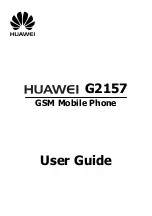
39
40
Your wireless phone is a radio transmitter and receiver. It is designed and manufactured not to exceed the emission
limits for exposure to radiofrequency (RF) energy set by the Federal Communications Commission of the U.S.
Government. These limits are part of comprehensive guidelines and establish permitted levels of RF energy for
the general population. The guidelines are based on standards that were developed by independent scientific
organizations through periodic and thorough evaluation of scientific studies. The standards include a substantial
safety margin designed to assure the safety of all persons, regardless of age and health.
The exposure standard for wireless mobile phones employs a unit of measurement known as the Specific Absorption
Rate, or SAR. The SAR limit set by the FCC is 1.6 W/kg. * Tests for SAR are conducted with the phone transmitting at
its highest certified power level in all tested frequency bands. Although the SAR is determined at the highest certified
power level, the actual SAR level of the phone while operating can be well below the maximum value. This is because
the phone is designed to operate at multiple power levels so as to use only the power required to reach the network.
In general, the closer you are to a wireless base station antenna, the lower the power output.
Before a phone model is available for sale to the public, it must be tested and certified to the FCC that it does not
exceed the limit established by the government adopted requirement for safe exposure. The tests are performed in
positions and locations (e.g., at the ear and worn on the body) as required by the FCC for each model. The highest
SAR value for this model phone when tested for use at the ear is 1.18 W/Kg and when worn on the body is 1.28
W/Kg (Body-worn measurements differ among phone models, depending upon available accessories and FCC
requirements). While there may be differences between the SAR levels of various cellphones and at various positions,
they all meet the government requirement for RF exposure.
For body-worn operation, the cellphone meets FCC RF exposure guidelines provided that it is used with a non-
metallic accessory with the handset at least 10 mm from the body. Use of other accessories may not ensure
compliance with FCC RF exposure guidelines.
SAR information on this model phone is on file with the FCC and can be found under the Display Grant section of
http://www.fcc.gov/oet/ea after searching on JYCBLADE.
Additional information on Specific Absorption Rates (SAR) can be found on the Cellular Telecommunications
Industry Association (CTIA) web-site at http://www.ctia.org.
* In the United States and Canada, the SAR limit for mobile phones used by the public is 1.6 watts/kg (W/kg)
averaged over one gram of tissue. The standard incorporates a substantial margin of safety to give additional
protection for the public and to account for any variations in measurements.
For this device, the highest reported SAR value for usage near the body is:
Maximum SAR for this model and conditions under which it was recorded
Alcatel 5049W(Body-worn)
1.28 W/Kg
HEARING AID COMPATIBILITY (HAC) FOR WIRELESS
TELECOMMUNICATIONS DEVICES
OUR COMMITMENT
We believe that all of our customers should be able to enjoy the benefits of digital wireless technologies. We are
committed to providing a selection of compatible devices for our customers who wear hearing aids.
THIS PHONE HAS A HAC RATING OF M4/T4. Reference ANSI C63.19 (2011).
FCC ID: 2AACJB089
WHAT IS HEARING AID COMPATIBILITY?
The Federal Communications Commission has implemented rules and a rating system designed to enable people
who wear hearing aids to effectively use these wireless telecommunications devices. The standard for compatibility
of digital wireless phones with hearing aids is set forth in American National Standard Institute (ANSI) standard
C63.19. There are two sets of ANSI standards with ratings from one to four (four being the best rating): an “M”
rating for reduced interference making it easier to hear conversations on the phone when using the hearing aid
microphone, and a “T” rating that enables the phone to be used with hearing aids operating in the telecoil mode thus
reducing unwanted background noise.
HOW WILL I KNOW WHICH WIRELESS PHONES ARE HEARING AID COMPATIBLE?
The Hearing Aid Compatibility rating is displayed on the wireless phone box.
A phone is considered Hearing Aid Compatible for acoustic coupling (microphone mode) if it has an “M3” or “M4”
rating. A digital wireless phone is considered Hearing Aid Compatible for inductive coupling (telecoil mode) if it has
a “T3” or “T4” rating.
This phone has been tested and rated for use with hearing aids for some of the wireless technologies that it uses.
However, there may be some newer wireless technologies used in this phone that have not been tested yet for use
with hearing aids. It is important to try the different features of this phone thoroughly and in different locations, using
your hearing aid or cochlear implant to determine if you hear any interfering noise. Consult your service provider
about its return and exchange policies and for information on hearing aid compatibility.




























